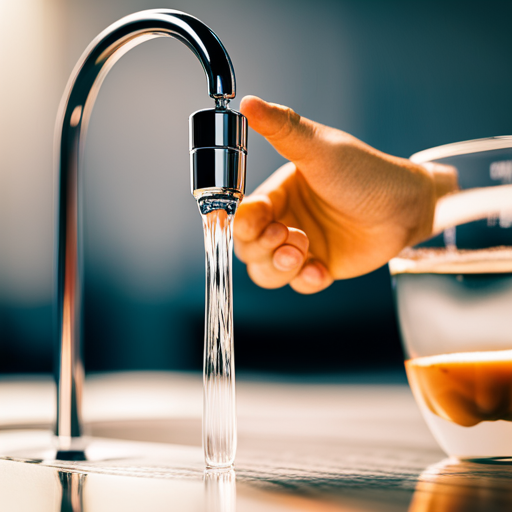Do you have concerns about the fluoride levels in your drinking water?
Reverse osmosis (RO) can provide a highly effective solution to remove fluoride from your water supply. This method uses a semipermeable membrane to filter out contaminants, including fluoride, with efficiency ranging from 84% to 99%.
While fluoride is added to some public drinking water supplies to prevent tooth decay, overexposure can lead to dental fluorosis and other health concerns. Therefore, it is essential to properly maintain your RO system and consider the potential for aggressive water that can corrode plumbing fixtures.
Additionally, remineralizers can be used to add back beneficial minerals to RO water. When choosing an RO system, it is important to consider your budget and specific filtration needs, such as fluoride removal.
Overall, RO water is a safe and effective solution to concerns about fluoride in drinking water.
Key Takeaways
– Reverse osmosis (RO) is an effective way to remove fluoride from tap water, with systems removing between 84% to 99% of fluoride.
– RO systems must be properly maintained to ensure fluoride removal efficiency and can create aggressive water that may corrode plumbing fixtures.
– Remineralizers can be used to add back minerals like calcium and magnesium to RO water, and pre-filter, carbon adsorption filter, and post-filter are important components of an RO filtration system for fluoride removal.
– Countertop, under-sink, and whole-house RO filters are available options, and filters should be replaced as recommended by the manufacturer. Testing drinking water for fluorine can help determine the need for fluoride removal using RO filtration.
The Basics of Fluoride in Water
You already know that fluoride is a mineral found in soil and groundwater that is often added to public drinking water supplies to prevent tooth decay, but there’s more to know about fluoride in water.
While fluoride toxicity is rare, too much fluoride over time can cause dental fluorosis, a condition that affects the appearance of teeth and may cause discomfort. The US Department of Health and Human Services recommends limiting fluoride in drinking water to 0.7 mg/L to avoid dental fluorosis in children.
Fluoride in water can also be a concern for those who want to avoid unnecessary exposure to chemicals in their drinking water. If you’re looking to remove fluoride from your water, reverse osmosis is an effective method. RO systems remove between 84% to 99% of fluoride and can help you achieve fluoride-free water.
RO Filtration for Fluoride Removal
Consider using a countertop or under-sink filtration system to effectively remove fluoride from your tap water. RO filtration is a proven technology that can remove between 84% to 99% of fluoride. However, it’s important to properly maintain your RO system to ensure maximum fluoride removal efficiency. This includes replacing filters as recommended by the manufacturer and regularly checking the system for any signs of damage or wear.
It’s also important to note that RO water can sometimes be corrosive to plumbing fixtures made of copper, iron, or other metals. To combat this, remineralization options can be used to add back important minerals like calcium and magnesium to the water.
Overall, RO filtration is a safe and effective way to remove fluoride from drinking water, but it’s important to properly maintain the system and consider remineralization options to ensure the best possible water quality.
Considerations for Choosing an RO System
When selecting an RO filtration system, it’s important to take into account your budget and specific filtration needs, especially when it comes to fluoride removal. Consider whether you need an under-sink, countertop, or whole-house system, as well as the cost of replacement filters.
Keep in mind that maintenance is key to ensuring the efficiency of fluoride removal, so make sure to properly maintain your RO system to prevent mineral buildup and other issues.
Another factor to consider when choosing an RO system is whether you want to add minerals back into your water after the fluoride has been removed. Remineralization options, such as adding a calcium or magnesium filter, can help balance the pH of the water and improve its taste.
However, keep in mind that adding minerals can also increase the risk of pipe corrosion, so it’s important to weigh the benefits and drawbacks before making a decision. Ultimately, selecting the right RO system for your fluoride removal needs requires careful consideration of both your budget and specific filtration needs.
Other Important Information
Adding minerals back into your drinking water after filtration can improve its taste and balance its pH, but it’s important to carefully weigh the potential risks and benefits before making a decision.
While remineralization can add essential minerals like calcium and magnesium back into your water, it can also increase the risk of fluoride exposure if your source water contains high levels of fluoride. It’s important to test your water for fluoride levels before deciding to add minerals back into your water.
In addition to considering the potential risks and benefits of remineralization, it’s also important to think about the environmental impact of your water filtration system.
Reverse osmosis systems can create wastewater that is high in contaminants, which can harm the environment if not properly disposed of. Look for an RO system that uses a permeate pump or other technology to reduce wastewater production and increase efficiency.
Additionally, consider the energy usage of your system and look for options that use energy-efficient technology to minimize your environmental impact.
